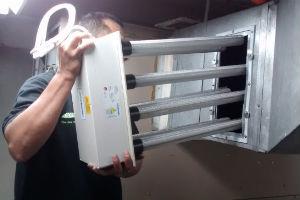 This kind of technology is presented as an interesting alternative to ensure optimal indoor air quality in different spaces.
This kind of technology is presented as an interesting alternative to ensure optimal indoor air quality in different spaces.
by Saúl A. Campuzano H.*
Indoor air quality (IAQ) has been an issue that has been gaining strength in recent years in different industries, among other reasons due to the high costs that absenteeism represents for companies derived from a bad IAQ and for the different international certifications, such as the LEED Certification (Leadership in Energy & Environmental Design) which, among its pillars, is the improvement of IAQ.
To achieve the optimal quality on this technical aspect, some alternatives are known, such as different filtration systems, ultraviolet light systems (UVC), ozone, outdoor air injection, among others, but are they really a real solution?
To obtain an air of optimal quality, many types of contaminants must be treated, among which are volatile organic compounds, the different gases present in the air, pathogenic microorganisms such as viruses, bacteria, molds and yeasts, among others... however, none of the methods mentioned above are completely efficient to control all contaminants, or even a high percentage, these solutions being incomplete and in many cases expensive.
Approximately two years ago, in Colombia there is a technology that is seen as a solution for the improvement of indoor quality called Bioclimatic bipolar ionization, this technology efficiently inactivates different types of contaminants regardless of their origin.
How does the technology work?
Bipolar ionization simulates in its glass tubes a natural effect compared to a thunderstorm, which converts air (98% nitrogen and oxygen) into active oxygen (bipolar oxygen ions, hydroxyl radicals, oxygen radicals and ozone formation).
Once the air is enriched, the different pollutants in real time are inactivated, because the ionization tubes are installed in the air supply, where the recirculation air and the air taken from the outside are mixed, allowing 100% of the supplied air to be purified, even inactivating contaminants present on the surfaces of the place and agglomerating the presence of dust in the environment to then be deposited on the ground.
Benefits of bipolar ionization
- Inactivation of pollutants: among the main benefits of bipolar ionization are the inactivation of gases such as Ammonium, benzene, 4-phenylcyclohexene, VOC, formaldehyde, hydrogen sulfide, methane, propane, CO, among others; as well as bacteria, molds, yeasts and odors.
- Production of bipolar oxygen ions: bipolar ionization is capable of producing more than 20,000 bipolar ions of oxygen per cm3 of air, which guarantees indoor air with ideal conditions, taking into account that in an air-conditioned office there are less than 100 bipolar ions of oxygen per cm3 of air, in an average city there are about 500 bipolar ions of oxygen and in a natural forest about 15,000 bipolar ions of oxygen per cm3 of air.
Applications
Food and beverages: these benefits allow industries such as food and beverages to prefer ionization for air purification in their production processes, due to the possibility of controlling the different types of contaminants, mainly bacteria, molds and yeasts, also this allows them to reduce their filtration systems, which are very expensive and high frequency in their spare parts (filters of 95% onwards and HEPA).
Commercial sector: the commercial sector is another great beneficiary with bipolar ionization technology, because air conditioning designers can use in their designs the IAQP (Indoor Air Quality Procedure) method of the ASHRAE 62.1 standard, and not the VRP (Ventilation Rate Procedure) as is regularly done.
The application of the IAQP allows engineers to calculate the Outdoor Air Flow according to pollution sources, pollutant concentration limits and the level of perception of indoor air acceptability, resulting in the possibility of recirculating a large percentage of the air, even up to 98%, which translates into savings of up to 40% in the costs of installing air conditioning and up to 50% in energy costs month by month, without taking into account the savings associated with monthly maintenance.
Medical Industry: according to the World Health Organization (WHO), hospital-acquired infections are a problem that affects more than 1.4 million people in the world annually and it is estimated that between 5% and 10% of patients admitted to a modern hospital contract an infection.
A large percentage of such infections occur by respiratory route due to poor indoor air quality within medical centers. Bipolar ionization allows the inactivation of bacteria, molds and yeasts and adding a photochemical oxidation technology module (UVC lights) will allow the elimination of viruses, such as H1N1, bird flu, Ebola among others.
This technology allows significant savings in high efficiency filtration system (HEPA filters) guaranteeing greater efficiency and lower costs in filters and energy.
Finally, it is important to emphasize that bipolar ionization technology can be installed in any mechanical ventilation system, air conditioning or in places without any type of ventilation, the benefits are very significant both for the processes in different industries, and for people who spend most of the day in their workplaces where it is vitally important to ensure that the 2,880 liters of air that a person breathes. in a Jordanian worker, they are of the best quality.
*Saúl Campuzano is the director of the company Ecovivir – Bioclimátic Colombia. You can be contacted at the email [email protected] – www.bioclimatic.com.co













